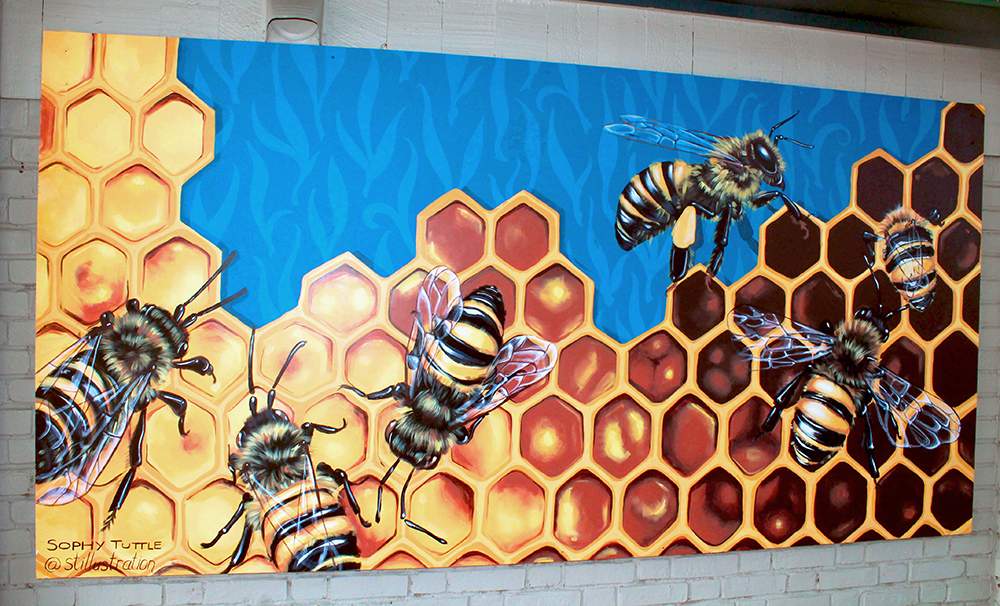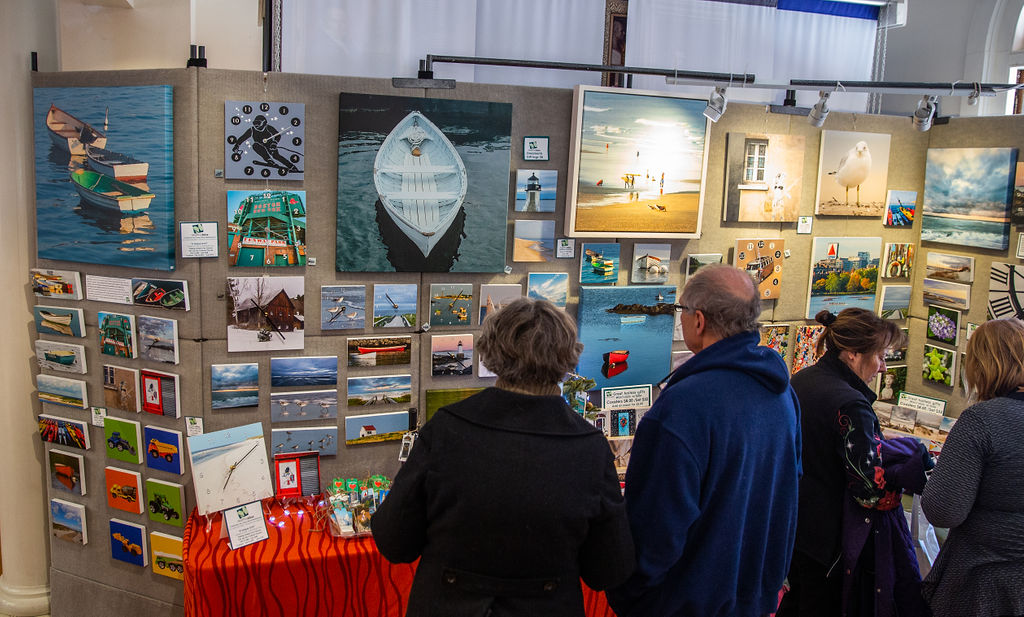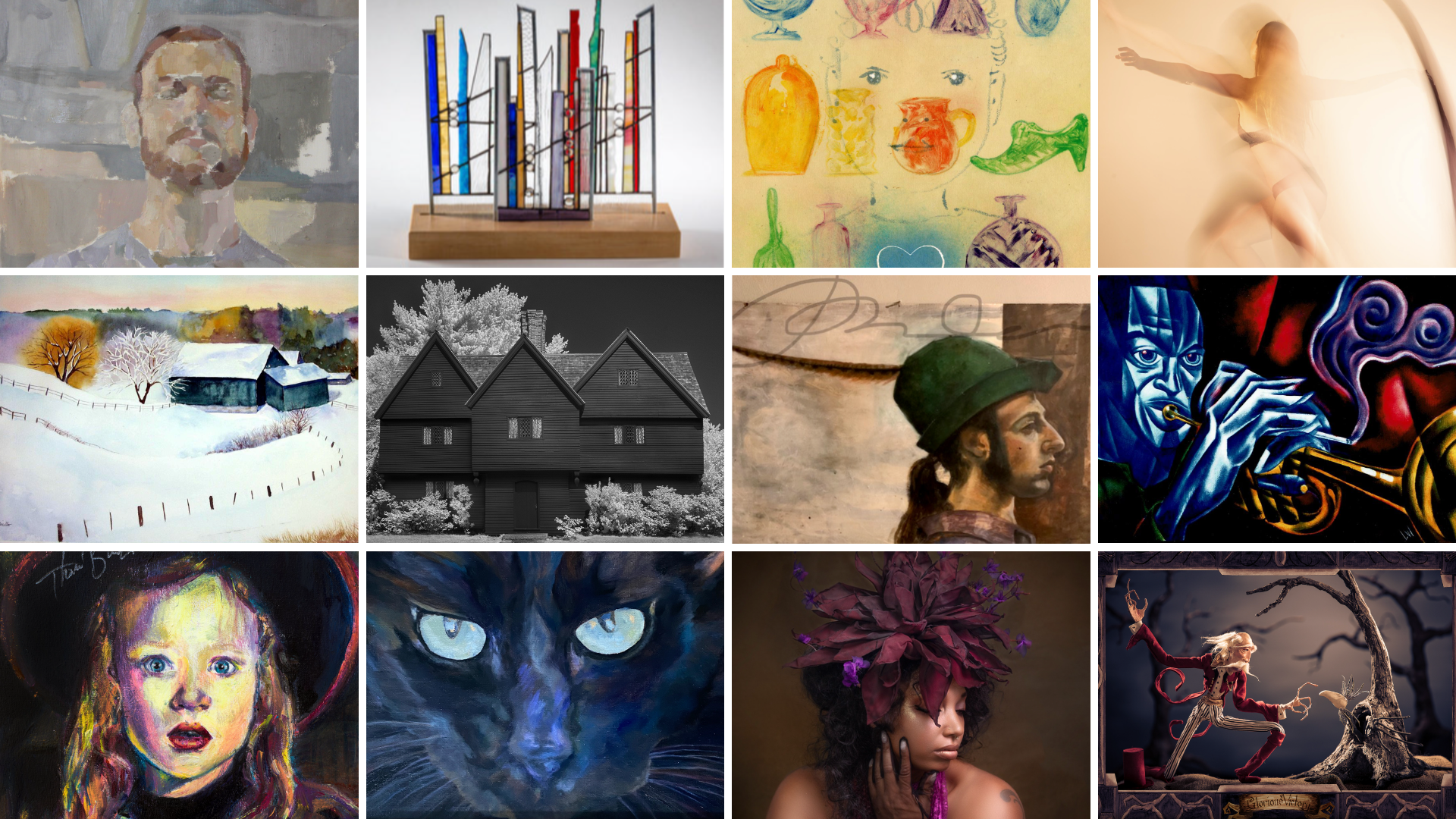by Joey Phoenix
“Only within the moment of time represented by the present century has one species — man — acquired significant power to alter the nature of the world. ” ― Rachel Carson, Silent Spring
“I consider it an extremely dangerous doctrine, because the more likely we are to assume that the solution comes from the outside, the less likely we are to solve our problems ourselves.” – Carl Sagan
I’ve been an admirer of Sophy Tuttle’s work since I first saw “Colony,” the people’s choice award winner of the 2018 Salem Arts Festival Mural Slam, in the beforetimes*. The vibrant, highly-detailed piece depicts a handful of buzzing bees keeping busy in their hive. The piece feels intimate, as if you’ve been invited into the bees’ living room where they’ve offered you a cup of honey and told you not to worry about cleaning up after yourself.


Sophy is an environmental artist who creates heavily researched and highly detailed work depicting images of wildlife in their natural habitats. Her murals have graced the walls of Mill No. 5 in Lowell, activated spaces along the Charles River Esplanade, and brightened the facade of Sikanda, a nonpartisan non-profit organization in Oaxaca, Mexico which works to promote sustainable development within marginalized communities.
For the past month, Sophy has been spending her days painting in Boston and on the North Shore, working on murals along the Mary Ellen Welch Greenway in East Boston for PangeaSeed Foundation’s Sea Walls Festival and completing her Goetemann Artist Residency at Rocky Neck Art Colony in Gloucester.
Public Art: A Conversation Between Strangers
In a testament to what public art can be, while Sophy’s work has impacted me before now, Sophy and I never officially crossed paths until I interviewed her for this piece. Two years ago I sat there in front of her work, absorbing it through my personal lens and determining what I thought the message of the piece was. Like with many murals, there was no artist’s statement, no guide to what I should think or feel when looking at it.
Perhaps for many, it was just a group of bees. Bees are pretty. They make honey and spend time in flowers. But from what I know of Sophy’s work, depicting wildlife is never “just” anything. And considering the impact of decreasing bee populations on our environment and our sources of food, there’s a lot that can be said about bees.
But that ambiguity falls into an artistic sweet spot. Public artists like Sophy will never meet the majority of people who experience their artwork, and so they become accustomed to conversations with strangers via their medium. Painting a mural means releasing the control the artist has both over who will see the work and how others will see and understand it. Anyone seeing “Colony” could walk away from it thinking “Bees are cool,” or, like me, feeling a sense unease concerning the state of our planet. They could also feel something else entirely.
As an ardent reader of naturalists like Terry Tempest Williams, Diane Ackerman, Rachel Carson, Mary Austin, and Jan DeBlieu – women who weave tales about the natural world in a way that allows me to understand what’s at stake on our planet, I am persistently drawn to visual art that follows similar themes.
Sophy does visually what these authors do with words, directing the viewer’s attention to what’s important, what the world is often completely missing amidst the routine of daily life.
She’s not offering solutions. She’s pointing out what’s there, and in doing so, showing us what we all might be about to lose. She’s keeping us accountable.
For example, her work at the Mary Ellen Welch Greenway focuses on the Saltmarsh Sparrow, a ground foraging creature who lives in tidal saltmarshes. As many of these stories go, the saltmarsh sparrow is a vulnerable species whose populations are declining rapidly, despite interventions by local wildlife biologists and ecologists. The Audubon Society predicts that the bird’s population could plummet from 53,000 to 5,000 within the next 25 years.
The PangeaSeed Foundation specifically directed the Sea Walls artists to create these pieces, giving the artists a range of creatures from which to choose, all of them focusing on rising sea levels and vulnerable populations. But not all of Sophy’s clients are so direct with their artistic asks, and instead offer up general ideas for her to start from for her pieces.
“One of my upcoming clients told me they wanted me to do something that had to do with art and science,” she said with a laugh. “It’s a little overwhelming being able to do whatever I want, but I’m also really excited.”
When planning her large scale pieces, whether she has specific direction from clients or festivals or not, Sophy often starts with Google and a Reddit Thread called “Nature is Lit” before moving onto interviews with scientists and others working in the field with themes she’ll be using in the mural .
“They have all the best information and don’t necessarily know how to communicate it as well as an artist would be able to, and I like being able to lend myself in that direction,” she added.
From Illustrator to Environmental Public Artist
This year, Sophy hasn’t let the Pandemic stop her from making the art she loves making, and in fact, it’s helped to remind her of why she’s wanted to make art from the very beginning.
“[Art] is the skill that I have that I can use to make a difference about things that I care about,” she said, and that in light of the pandemic and how it’s been exacerbated by climate change, “it seems really obvious to me that [working to solve these issues] is just the next step. I see a connection within everything, a lot of people do.”
Sophy started her career primarily as an illustrator, getting her BFA from the acclaimed Rhode Island School of Design (RISD) in Providence. But over time, she began to feel the call of artistic field work with the ability to convey meaning that moves beyond the decorative and into something more impactful. She was drawn to public art specifically because of how widespread that impact can be, but initially transitioning to this medium proved to be somewhat of a challenge.
“As illustrators we were trained to convey a specific message because successful illustration conveys what you want it to,” she explained. “So I came into public art thinking like, Okay, I have to be able to get a very specific message across and it can’t be misinterpreted.”
After collaborating with fellow artists and learning more about the process of public art in the field, her expectations and intentions around the pieces she was creating began to shift towards a more open minded approach. She was able let go of the need to control how people interpreted the message and focused on letting the art speak for itself.
“You can’t control everyone’s thoughts and feelings and dreams,” she said. “So I think it’s important to embrace [these interpretations]. And sometimes people will come in with a really cool interpretation, something that I haven’t thought of, and then I learned something new. It happens all the time.”
These ongoing conversations allow artists like Sophy to drop messages into the public eye without having to constantly be there to check up on that communication.
“Public art, at the very least, it gets people to stop and maybe think about what it might mean,” she said. “But on a bigger scale, as it’s finished and I walk away, the message is still there that I’m trying to convey about climate change and sea level rise. It’s on people’s minds to begin with, these murals can keep the conversation going.”
Pieces like Sophy’s are jumping off points for viewers to be able to observe and connect with our world. For every 99 people who will walk by a painted wall and think, “oh, isn’t that nice,” there will be one or two who recognize it as a call to action, to see the world as a rare commodity to be respected and protected, and then do something about it.
Or so we can hope.
You can follow Sophy’s work on her instagram page @sophytuttle or on her website (https://sophytuttle.com) which she updates frequently.
*pre-Pandemic
Joey Phoenix is an interdisciplinary artist and manic scribbler who spends a great deal of time admiring Bobtail Squid and daydreaming about what it would be like to live in the ocean. They are the digital content manager for North Shore Pride, the Managing Editor of Creative Collective, and the co-founder of Moonrise Fae. Please e-mail them with thoughts and story ideas at joeyphoenix@creativecollectivema.com. They will write back, albeit not right away.
Support Accessibility on the North Shore
Creative North Shore is having ongoing discussion of Accessibility and Disability Awareness leading up to the International Day of Disabled Persons on December 3 and the hopeful introduction of a Disability Parade in 2021. If this is a topic you are interested, have thoughtful story ideas, or know of an organization to add to the list below please reach out to joeyphoenix@creativecollectivema.com
Organizations to Support








